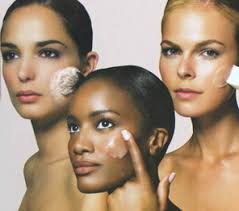To make your lips look fuller, start by concealing your natural lip line with a concealer. Line your lips just outside your natural lip-line. Smudge the lip-liner onto your lips to soften the look of the liner. Apply the lipstick with a lip brush on your lips and cover the new lip line created with the lip liner. This will create natural fuller looking lips. Using lighter colours and lipstick with a frost or shine will also give your lips a fuller look. If you prefer darker colours add a little spot of a light shimmering colour to the centre of the top and bottom lips. This will add contour and give a more, pouty look.
Category Archives: Colour
Make Larger Lips Look Smaller
To make your lips look thinner and smaller, hide your natural lip line with concealer. Line the lips just inside your natural lip line. Smudge the lip-liner onto your lips to soften the line. Apply your lipstick onto the lips keeping the colour inside the new lip line created with the liner. This will create the illusion of thinner lips. Using a darker lip liner and lip stick without shine or shimmer will also make the lips look thinner and smaller.
Why Wear Colour Effectively?
Colour analysis is a scientific practice that has evolved over the past 100 years, and for good reason. Colour can affect your mood and the moods of others around you. It will influence your perceived size and body shape, as well as reveal your mood, personality and sense of fashion. Not only that, but It can also make you appear healthier and more attractive.
Colour analysis is a great way of determining which colours are right for you and will enhance your personal colouring. It is also a great way to coordinate a workable, versatile wardrobe that can be easily mixed and matched. As you become more aware of colour and relate it to your own colouring and appearance, you can make more appropriate choices that will save you time and money.
Change Your Body Shape with Horizontal Details
Horizontal details or lines in clothing shorten and widen the body because the eye follows the direction of the lines. Most horizontal lines are created by a contrast in colour or texture, as in prints, design details, accessories or tops and bottoms in contrasting colours or tones. Although their power to make you look heavier may tempt you to avoid them altogether, a wardrobe with no horizontal details would be very boring. Instead strategically use them to your advantage. To balance full hips use horizontal details like bateau necklines, yokes and other details on the upper part of the body. This will make your shoulders look wider and your hips will look slimmer.
How to Change Your Body Shape
When we refer to body shape or body type we are usually referring to the silhouette of the body formed by the structure of the hips, shoulders and waist. These three body parts form the shape of the body. There are many different ways that we can describe these body shapes. Some image professionals use geometrical labels. Some personal image experts use letters. And there are many other labels that describe body shapes and types. However, if you consider what they are saying it comes down to the following:
- The shoulders are wider than the hips
- The hips are wider than the shoulders
- The hips and shoulders are the same width and the waist is much smaller
- The hips and shoulders are the same width and the waist is not much smaller
- The hips and shoulders are the same and the waist is larger
Once you have determined your body shape it will make it much easier to decide if you want to dress to emphasize or to camouflage your body shape.
Change Your Body Proportions with Clothing
Clothes can help give the illusion of how we want to appear. If we know how to choose the right silhouettes, lines, fabrics and colours, we will appear more evenly balanced and proportioned. The proportion and line of our clothing must work with proportion of our bodies. The key is to understand our own specific proportions in order to be able to find clothing with the lines and shapes that will enhance our individual body type.
Your Best Foundation Colour
Choose your foundation as close as possible to your skin colour. The best place to test this is at the jaw line. The reason we test the colour her e instead of the wrist, cheek or forehead is because the skin colour will be different on every area. The colour of your neck will be different than the colour of the skin on various parts of your face.
e instead of the wrist, cheek or forehead is because the skin colour will be different on every area. The colour of your neck will be different than the colour of the skin on various parts of your face.
Your best colour will blend into your skin tone at the jaw line and look natural next to the skin tone of your neck. Happy testing…
Choosing Your Foundation
The right foundation will last on the skin, be comfortable to wear and give you the right amount of coverage that suits your personality and needs. Choose foundation based on four things:
- Your skin type – knowing your skin type before you buy will save you a lot of head aches. It will make your foundation last longer and be more comfortable. For example a dry skin would likely want a foundation that adds nourishment and moisture to the skin. An oily skin would likely want something oil free.
- These days there are so many choices for foundation formulas. Although liquid is still the most popular, consider cream, wet-dry or mineral powder. Each foundation has different qualities.
- Coverage is something you should consider before buying your foundation. Do you want a natural look, a flawless complexion or something in between?
- After you have determined your preferences based on skin type, formula and coverage it is time to decide on finish. Finish is like the finishing touch. This is also where fashion and personal preference come into play. Do you want a matte finish, satin finish, velvety finish? There are lots of options. Choose the one you like the best or go for fashion.
Once you have narrowed this down then it is time to choose the colour. I will tell you all about it in my next blog post.
Make Your Make-up Last
Clients always ask me how I get my foundation to last all day. The secret – finish your foundation with a light dusting of translucent powder. With a powder brush, press the powder into the skin. Then dust off the excess in a downward outward motion.
Conceal Blemishes and Dark Circles
Using a q-tip or a fine concealer brush, apply concealer to any area that needs extra covering. The best concealer colour is one that matches your foundation or the colour of the skin next to the concealed area (if you are going Au naturale). With your ring finger pat and press it into place. Concealer can be applied alone, on top or below foundation.




